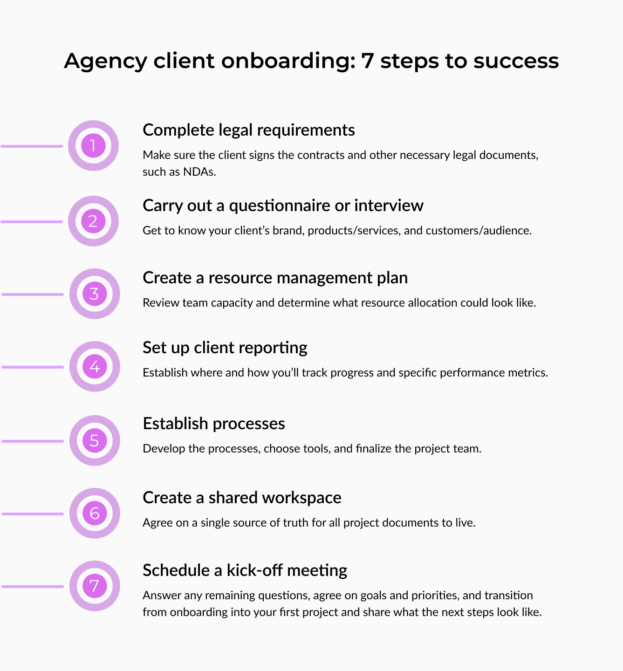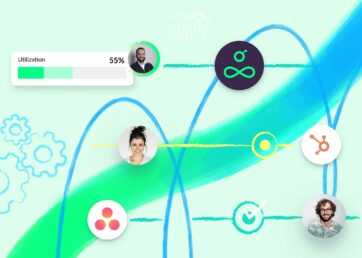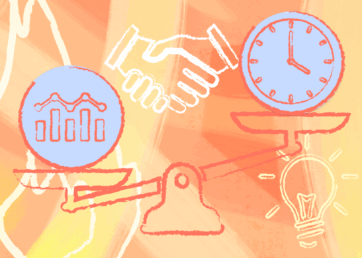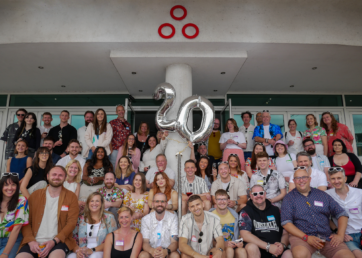It’s tempting to think the hard part is over as soon as you’ve won the client. Your pitch was the winner, but is your agency client onboarding experience just as good?
Because it needs to be. It’s what will set the tone for the rest of your client-agency relationship.
It doesn’t take rocket science to figure out that strategic and customer-led agency client onboarding will set you up for success.
Here, we’ll show you how to do just that.
In this article 📖
What is agency client onboarding?
Agency client onboarding is the process of introducing and integrating a new client into your business. This is a crucial step in establishing a successful and long-lasting working relationship.
The onboarding process typically involves several steps and activities, aimed at ensuring a smooth transition and a clear understanding of the client’s needs and expectations.
This might include:
- Sharing all necessary onboarding documentation around project management processes, collaboration, and team setup
- Collecting relevant information and building a deeper understanding of the client’s brand as well as audience
- Understanding the needs and goals of the key stakeholders in their business
- Creating the first project scope and other project documentation
- Familiarizing the client with your agency workflows
- Establishing clear expectations for collaboration and project success going forward
- Choosing the appropriate project management software you need to collaborate effectively across the project life cycle
- Putting together the project team and introducing them to the client
“The client onboarding period is the honeymoon phase of the B2B customer relationship… Often so much of a company’s investment is in winning the customer, but it is just as important to onboard well and build a long-term relationship.” – Allison Bennett, Chief Marketing Officer, JPMorgan Chase
Why is agency client onboarding so important?
Agency client onboarding sets the foundation for a successful (and lasting) partnership. The primary goal of agency client onboarding is to ensure that the transition from those first sparks of the pitch to a long-term relationship goes smoothly.
You may have made a great first impression throughout your sales process, but it’s the alignment between the RFP/ pitching and the onboarding phase that creates the initial set of expectations. It’s an early indicator that your team is able to safely deliver on the promises made during the pitch.
If an agency doesn’t intentionally and strategically begin to build its relationship with the client from the start, it often leads to miscommunication, mistakes, and misalignment later down the line.
“We often find the most critical juncture of a B2B relationship begins on the first day that someone can be called a “customer.” This is the onboarding phase—the period of days, weeks, or months immediately following the contract signature when two organizations set the foundation for their working relationship. This time represents a critical inflection point when trust—and value—will be won or lost.”
– Rob Sherrell, Global Customer Experience Lead, and Todd Nisbet, B2B Onboarding Lead, North Highland
Agency client onboarding process: 7 steps to success
Whether you’re a seasoned agency looking to fine-tune your approach or a new agency embarking on this critical journey for the first time, it’s useful to reflect on your client onboarding process.

1. Complete legal requirements
Contracts are more than just paperwork; they are the foundation of a strong relationship in any B2B (business-to-business) setting, and it’s important to square away any issues upfront. You don’t want any legal matters looming over you for the remainder of the agency client onboarding phase.
Turning a verbal agreement into a written contract solidifies your commitment and protects both parties.
During this stage, it’s essential that you:
- Send the contract and have your client sign it
- Address any necessary NDAs (Non-Disclosure Agreements)
- Collect relevant tax and financial information for invoices, payment details, and communicate payment expectations
- Make them aware of any boundaries you have to protect your employees’ work-life balance (for example, this might apply to team availability as well as the risk of scope creep)
“We have language in our contracts that communicates the typical working hours of our team. For example, this might say we’re available from 9 am to 5 pm Eastern time. It also states that we’re not available over the weekend, except for 24/7 types of contracts.”
– Amirreza Farhadi, Associate VP of Operations at Havas CX Canada
Discover how Havas CX Canada sets boundaries with Resource Guru
2. Agency client onboarding questionnaire or interview
When it comes to onboarding a new client, it’s important to make the time to truly understand your client’s needs. The perfect way of doing this is opening with an onboarding questionnaire or interview.
Founder of Perfect Data Marketing Agency, Paul Bonea, advocates active listening sessions to initiate the client onboarding process: “The purpose of the session is to understand the ins and outs of the company.”
This unique approach allows your clients to share their thoughts and experiences openly, providing you with invaluable and unfiltered feedback. There’s no other time in the process quite like this, where you can gain such honest insights.
25 questions to ask in your agency client onboarding interview
Consider using the questions below for your agency client onboarding interview. You can tweak them based on the client, or use them as they are.
- Tell us something we wouldn’t know about the products and/or services you offer.
- What are your main goals for [x campaign], ranked by importance?
- What success metrics matter to you for this project?
- What challenges have you faced in achieving these goals to date?
- Please share any further details about your target audience and your ideal customer profile.
- Do you have any user persona or ICP documentation?
- Who do you consider your top 3-5 competitors, and why?
- Which team members will we work closely with, and who will be our main contact?
- Do you have a team structure document you can share?
- Who is the key decision maker?
- What is the sign-off process?
- Who will be providing feedback?
- If you have brand guidelines, please share them with us.
- Do you have any other guidelines, such as TOV or design?
- What have been your most successful past advertising or marketing initiatives? Tell us more.
- Have you worked with an agency previously?
- If so, what went well, and what can we do better?
- What communication tools do you currently use internally and externally? (Email, phone, video calls, Slack, etc.)
- How would you like us to communicate with you? Channels, frequency, etc.
- What tools do you currently use? (Hubspot, Semrush, Hootsuite, etc.).
- Which of these tools would we need access to?
- Are you open to using new tools that are part of our agency tech stack?
- Can we access any other relevant tools or platforms (e.g. social channels)?
- Can you share any documentation of your sales journey with us, so we can understand customer journeys?
- And lastly, do you have any questions for us?
The answers to these questions will help you decide how to handle your agency client onboarding, as well as the relationship moving forward.
When designing your interview, think about:
- The amount of time it will take for your client to answer them. Don’t have more than 25 questions or let the interview go on longer than 90 minutes.
- How you can make it easy for the client to answer the questions? For some it will be answering them live over Zoom calls, for others, it will be an async Google questionnaire.
- Propose a deadline when you send the questionnaire off to get momentum going.
- Encourage them to contact you with any questions or concerns.
- Make sure you’re not asking questions that your agency team should already know. This means great internal communication, and information sharing between new business/pitching teams and the account/execution team.
3. Create a resource management plan
As soon as you’ve landed a new client, it’s time to look at resource capacity planning and potential allocation. What does team utilization look like? Do you need to start looking for freelance support? Should you hire more staff? Does a designer need to be pulled off of another project?
Future-proofing your resource capacity now will save you a lot of headaches later on, and set you up for long-term success with your new client.
4. Set up client reporting
According to a Harvard Business Review survey, only 49% of executives agreed that firms leverage data and insights to understand and predict higher-level customer needs. The study goes on to hypothesize these low numbers may be driven by a somewhat surprising lack of metrics for success during the onboarding period.
Establishing where and how you’ll track your progress and specific performance metrics from the beginning is key to clients understanding and recognizing your value. That’s why it’s important to make sure you have the right agency tools to support your data and reporting needs.
Try and simplify your client reporting as much as possible. Rather than manually checking various platforms like Semrush, HubSpot, Google Analytics, and Facebook, integrate all your clients’ unique marketing channels into one user-friendly, automated reporting platform.
It’s also useful to set up benchmarking reports. That way, you can clearly showcase the impact you had before and after being brought on as an agency partner.
5. Establish processes
Using the client’s answers to your questionnaire or interview, it’s time to develop the processes, choose the tools, and pick the project team that’ll help achieve those shared goals.
This might include:
- Adding the client to your agreed-upon shared tech stack
- Asking the client for access to any documents or software you need
- Establishing any recurring meetings between key stakeholders
- Future-proofing your capacity planning and resource scheduling, by adding the client to your resource capacity planning tool
- Considering how your SOPs (standard operating procedures) work with this client
Now, you may have discussed and agreed on certain processes with your client, but if a process is agreed upon but no one’s there to document it, did it ever really exist?
6. Create a shared workspace
Wiki, notebook, portal, or workspace—call it what you want—but all of the information you’ve gathered needs to be put somewhere that’s useful for everyone. Ideally, this workspace will be a tool you’ve all agreed to use as the single source of truth for the duration of your partnership.
Tools like Notion, Asana, or OneNote are great places to share knowledge. Get your key stakeholders to review and agree to written-up processes so you can send them out to everyone involved in the agency-client onboarding.
Think about writing up and keeping a record of:
- How, when, and where you and the client will kick off projects
- What needs to be included in a brief?
- How, when, and at what stage your agency will present work?
- How clients will give feedback.
- When clients will approve creative work
- How you’ll handle emergencies, from international incidents to in-house personnel crises
- How you will review projects as a team to improve over time
- How often will you and the client meet?
As well as basic details like:
- Team contact details and bios
- Summary of marketing goals
- Summary of your services
- What your tech stack looks like and login information
- Financial information
It’s worth bearing in mind that a recent Wyzowl study found that 69% of people believe video should play a more prominent role in the onboarding experience.
If your clients are happy with it, include videos where you talk them through the workspace, and specific tools or issues. For example, a Loom video of you demoing their new reporting dashboard.
7. Schedule a kick-off call or meeting
The purpose of this call is threefold:
- Answer any questions your client may have about the agency-client onboarding so far
- Agree on goals and priorities for your first project
- Transition from onboarding into your first project and what the next steps look like (this may be more strategic than execution-led)
Think of it as a test drive for all the processes you and your client have just discussed and established. Remember to remind both yourself and your client that good processes don’t become habits overnight. It will take time, dedication, and probably a few mistakes along the way to find your stride.
Consider exploring these issues in your kick-off call:
- Ensure everyone understands your shared tools, knows where demos are in your workspace, and has a point of contact for tech issues.
- Introduce your team and get to know theirs. Make sure everyone shares both their relevant skills and demonstrates their expertise, so they have full faith in your resource allocation. Don’t forget to include personal details to start building rapport and more meaningful relationships.
- Discuss the project roadmap and make any final tweaks. Consider whether you need to run a separate prioritization workshop to create a more accurate project timeline.
- Confirm the project milestones for the project, and how you’ll be measuring these.
- Allow ample time for client questions to make them feel heard and taken care of.
💡 Pro tip: If it’s possible, meet your clients face-to-face to build rapport. After the meeting, bring your clients to your favorite restaurant to get to know them in a more relaxed setting. Wining and dining your clients can go a long way.

Roger Sterling and Don Draper make a toast at a client dinner.
Communication during agency client onboarding
One of the biggest mistakes agencies can make during onboarding is not communicating clearly what they’re doing and why. Winning a pitch and then going radio silent for two weeks can make clients suspicious that you’re not going to deliver, even if during those two weeks you’re working solidly behind the scenes.
In fact, roughly half of the executives surveyed by the Harvard Business Review listed insufficient communication as a significant challenge during onboarding.
Time to value (TTV) is a useful metric to consider in agency client onboarding. If you jump into projects without onboarding as a foundation, you’re likely to deliver subpar work in an unsustainable way. Plus, you’ll probably end up creating more work for the team because you’re not aligned on the outcomes.
On the flip side, if your onboarding process drags on for too long and the client may question whether you can deliver.
The solution? Communication and clarification—upfront. Keep your client informed every step of the way about what you’re working on and how it adds value to your partnership. Drip-feeding deliverables to your clients is a great way of keeping the momentum going and getting feedback faster.
Why not try out our onboarding email template to get your communication with clients off to a great start?
Agency client onboarding email template
Nothing beats a great welcome email. The kind that gets everyone really excited for what’s to come. The key ingredient? Personalization.
Yes, use a template for the structure, but always include the key intel you’ve picked up throughout conversations so far during the pitching process and sales cycle.
Here’s what to think about:
- Keep it short and clear
- Explain what happens next
- Give clear actions to take
- Provide a timeline for the onboarding process
Subject line: Welcome to [Agency Name]
Email copy:
Hi [Client Name],
On behalf of the entire team at [Agency Name], welcome!
We’re all incredibly excited to partner with you and have a huge impact on [key area x].
This is what the onboarding process will entail:
- Signing the contract and any other legal documents required
- A discovery phase. This will involve answering an initial questionnaire or interview, so we can better understand your team, needs, brand, goals, and audience
- Setting you up with our tech stack as needed (and getting access to any of your tools in return)
- Choosing your preferred reporting methods and frequency
- Setting up a shared source of truth to record processes and decisions
- Scheduling our project kick-off call or meeting
- Team introductions
We expect this process to take [X weeks]. You’ll have full visibility of the onboarding process and its progress [here] in our project management tool.
Next steps:
- Review and sign any remaining legal documents
- Schedule some time for an initial interview using [this link]. If you’d rather answer the questions via a Google Form, please use [this link].
I’ll be your main point of contact, so any questions or feedback, please just get in touch. Consider me an extension of your team. :)
[Name] [Title/Position] [Agency Name] [Contact Information]
Ad agency client onboarding process (Leo Burnett and McDonald’s use case)
In the mid-1980s, Leo Burnett won the McDonald’s account through a pitch that demonstrated creativity, strategic insight, and a deep understanding of the brand. Their ad agency client onboarding process continued to emphasize those qualities.
- They understood the brand: They recognized the importance of the golden arches and the association of McDonald’s with happiness, convenience, and family-friendly experiences.
- They built a strong relationship: Leo Burnett prioritized active listening and effective communication from the outset with McDonald’s. Regular meetings and open dialogue allowed both parties to exchange ideas, provide feedback, and collaborate on the advertising strategy.
- They shared McDonald’s vision and values: They understood that McDonald’s wasn’t just about selling fast food; it was about offering an experience, happiness, and a sense of togetherness for families and individuals.
Marketing agency client onboarding process (Wieden+Kennedy and Nike use case)
In the early 1980s, Nike was a relatively young athletic shoe brand looking to break into the competitive sportswear market. Here’s how the agency Wieden+Kennedy secured the Nike account, and their subsequent marketing agency client onboarding process:
- They emphasized storytelling: Wieden+Kennedy’s approach focused on storytelling rather than merely promoting the products. They showed athletes as both everyday heroes and celebrities, inspiring the audience to push their own limits.
- They created an emotional connection between the brand and the audience: From the outset, Wieden+Kennedy recognized Nike wanted to show that sport was about so much more than just the physical.
- They had mutual respect and compromise: Weiden recalls how when he suggested the now iconic Just Do It tagline during an early campaign he said that “Nike questioned it…[I told them] we have too many disparate commercials that don’t add up to anything without a tagline. I’m not married to the thing. We can drop it next round.’ A lot of shrugged shoulders, but they let it ride.”
And the rest, as they say, is history.

Dan Wieden, the man behind Nike’s “Just do it” slogan.
Get your agency client onboarding right to set the tone for the future
The agency client onboarding process is essential for building successful partnerships. Understanding client needs, clear communication, and defined timelines foster trust and satisfaction.
By being intentional and methodical with your onboarding, you’ll prevent misunderstandings, scope creep, and delays, leading to better outcomes and long-term loyalty.

The #1 scheduling and time tracking tool trusted by thousands of project teams
Join thousands of project managers who have made scheduling a breeze.






